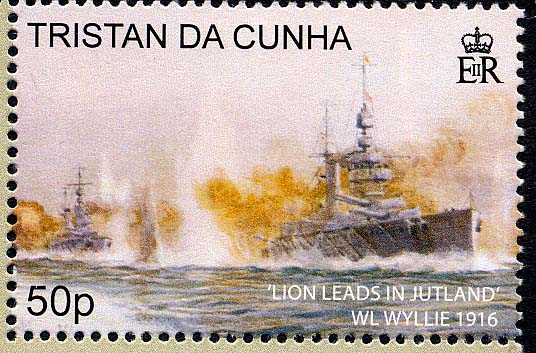
Builder: Devonport Dockyard
Laid down: 25 November 1909
Launched: 6 August 1910
Commissioned: 4 June 1912
Struck: 1924
Fate: Sold for scrap
General characteristics
Class and type: Lion class battlecruiser
Displacement: 26,250 long tons (26,670 t) standard
29,680 long tons (30,160 t) maximum
Length: 700 ft (210 m)
Beam: 88 ft 7 in (27.0 m)
Draught: 27 ft 6 in (8.4 m)
Propulsion: Parsons steam turbines, 4 shafts, 42 boilers, 70,000 shp
Speed: 27.5 kn (50.9 km/h)
Range: 5,610 nmi (10,390 km) at 10 kn (19 km/h)
Complement: 997–1,267
Armament: 8 x BL 13.5 inch /45 naval guns
16 x BL 4-inch (101.6 mm) /50 Mark VII guns
2 x 21 in (530 mm) torpedo tubes (submerged)
Armour: Belt: 9 inches (230 mm)
Bulkheads: 4 inches (100 mm)
Barbettes: 9 inches (230 mm)
Turrets: 9 inches (230 mm)
Decks: 2.5 inches (64 mm)
HMS Lion was a battlecruiser of the Royal Navy launched in 1910, the lead ship of her class (known as the "Splendid Cats"). She was originally constructed with her foremast and spotting top behind her forefunnel; the heat and fumes made access to the spotting top difficult and after her initial trials she was rebuilt with the foremast and fore funnel switched in position. In World War I she fought at the battle of Heligoland Bight, 28 August 1914, and served as David Beatty's flagship at the battles of Dogger Bank, 24 January 1915 and Jutland, 31 May 1916, and was sold for breaking in 1924 under the terms of the Washington Naval Treaty.
At Dogger Bank, she scored a somewhat lucky hit on Seydlitz which caused a cordite flashback which burned out the latter's two rear turrets. While it nearly resulted in the destruction of the Seydlitz, the Germans gained crucial insight into improving magazine safety that would make the difference in the future battle of Jutland.[1] In response she was struck by a salvo from the German battlecruiser Derfflinger which crippled her, forcing her to fall out of line and Admiral Beatty to lose control of his squadron until he transferred his flag to HMS New Zealand.
At Jutland she was hit by a 12 inch (305 mm) salvo from the Lützow which blew the roof off of the "Q" turret. Dozens of Royal Marines were killed, but a far larger catastrophe was averted when Major Francis Harvey, the mortally wounded turret commander, ordered the magazine doors shut and allegedly ordered the magazine flooded, thereby preventing the cordite propellant from setting off a massive explosion. He was posthumously awarded the Victoria Cross.
The future First Sea Lord John H. D. Cunningham served aboard her as navigator for the last year of the war.
Account of the battle of Jutland by Alexander Grant, a gunner aboard Lion.
Picture on stamp by Marine Artist WL Wyllie
